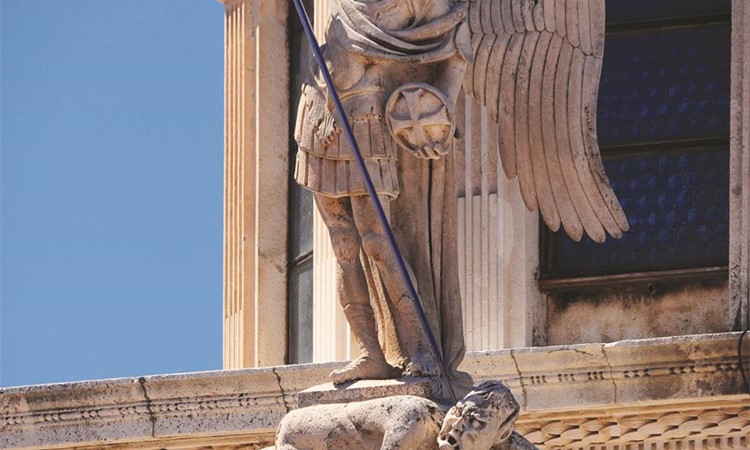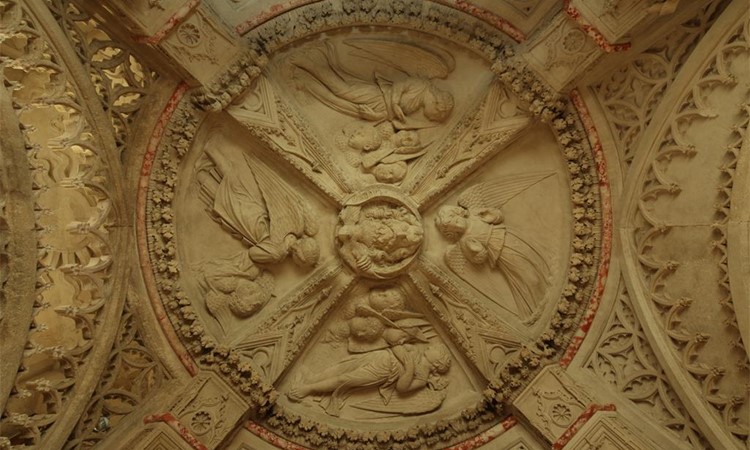The Cathedral of St. James
The unique monument of European sacral architecture
The Cathedral of St. James is the most valuable architectural monument built during the 15th and 16th century in Croatia. According to its beauty, construction techniques and style characteristics, it is not only the biggest and the most valuable object of the architectural heritage in the town of Šibenik but it is also the unique monument of European sacral architecture. According to its artistic value, it belongs to the most valuable European monumental cathedrals, and thanks to some of its features, it is unique not only among the cathedrals but among Christian churches in general!














The only construction in the whole of Europe built entirely of stone
It is the only cathedral in the whole of Europe constructed entirely of stone, as no wooden architectural elements nor a bonding plaster were used for its building. It is also the first construction in Europe whose assemblage was based on the unique system of inter-grooved stone plates (other constructions based on this system originate from the 19th century), as well as the only construction whose outside volume completely corresponds to the shape of its interior. The Cathedral of St. James is also well known for its iconographic innovations, among which the frieze of 74 head sculptures (individual portraits of the contemporaries of Juraj Dalmatinac) takes special place. It is considered to be the most numerous portrait gallery of the highest quality exhibited as the public monument on a sacral object in Europe. On the vault of the baptistery was also introduced the relief representing Father God with the dove of the Holy Spirit and angels.
105 years of construction
The cathedral was constructed on the south side of the central square of the oldest town core, on the site of the former Romanesque Church of St. James. The idea of the construction of a big cathedral temple derives from the 13th century, when Šibenik was given the status of a town and its own diocese. The construction with several interruptions lasted for 105 years, from 1431 until 1536, beginning in the Venetian Gothic style and finishing in the Tuscan Renaissance style.
The old masters: Juraj Dalmatinac, Nikola Firentinac and the others
Šibenik Cathedral is a three-naved 38 m long and 14 m wide basilica, and its highest point is on the top of the cupola. During the first decade of the 15th century the construction of the cathedral was led by Venetian architects Francesco Giacomo, Antonio Busato and Lorenzo Pincino, as well as Šibenik's stonemasons Andrija Budčić and Grubiša Statčić, but in 1441 Juraj Dalmatinac was appointed proto-master and worked on the construction until his death in 1475. As the master of the late Gothic flower style and the initiator of the Gothic-Renaissance style in Dalmatia, Juraj Dalmatinac changed the initial plan of the church, giving it its monumental importance. The construction of the cathedral was after his death continued by Nikola Firentinac in the pure Renaissance style. Since the cathedral had not been finished, the construction was after Firentinac taken over by Venetian architects Bartol and Jakov from Mestre and Zadar's master Mestičević.
The Baptistery as the well of Life
In the cathedral's interior the baptistery draws particular attention, because of its original and creative synthesis of two different art styles of the first half of the 15th century, the Late Gothic and the Early Renaissance. The cathedral represents the first finished architecture in the Renaissance style, constructed only 20 years after the real beginning of the Renaissance in Tuscany. The most impressive feature of the baptistery is the abundance of sculptural decoration, among which the human figure is the most represented one. Besides the sculptures of the four prophets (of which only two are preserved until today), the whole vault is decorated with reliefs of angels, cherubs' heads and the impressive head of Father God. The baptismal font is located in the centre of the baptistery, carried by three plump naked boys in movement, made by Juraj Dalmatinac.


The Interpretation Centre ‘Civitas sacra – Sacred City’, located in the medieval Galbiani Palace, gathers the rich history of the Diocese of Šibenik in one place and tells its visitors tales of the specific features of the construction of the Šibenik cathedral that were revolutionary for the architecture of its period, as well as of the importance of this building for the history of Šibenik and its cultural importance for the entire region of Šibenik. Its story is also a story of people – the natives of Šibenik whose efforts made the erection of this magnificent edifice possible.







The Venetian Defence System
St. Nicholas Fortress, one of the newest additions to the list of UNESCO World Heritage Sites, as an integral part of the 15th to 17th century Venetian Defence System, was constructed during the 16th century and located at the entrance to St. Anthony's Channel. Building of the fortress was an important undertaking not only for the citizens of Šibenik but also for those who ruled it, as it was built in order to protect the town from Turkish attacks from the sea. The fortress erected at the entrance to the narrow mile long channel became the important strategic defensive structure that contributed to the impregnability of Šibenik Port and the town of Šibenik itself. The only entrance into Šibenik Bay was through the channel, which made possible the effective defence and complete control of the entry of ships.






The Fortress Of Alla Moderna
In construction of St. Nicholas Fortress the military aspects were given more importance than the ornamental ones, however the fort is still the typical Venetian creation of "alla moderna", an extraordinary example of the isolated defence work risen in the sea. The fortress was built after the plans of Venetian military architect Michele Sanmicheli, as white stone was used for building the lower parts of the fort and red stone for the upper parts. St. Nicholas Fortress until today remains one of the strongest and the most fascinating maritime fortifications built along the coast of the Adriatic Sea.

